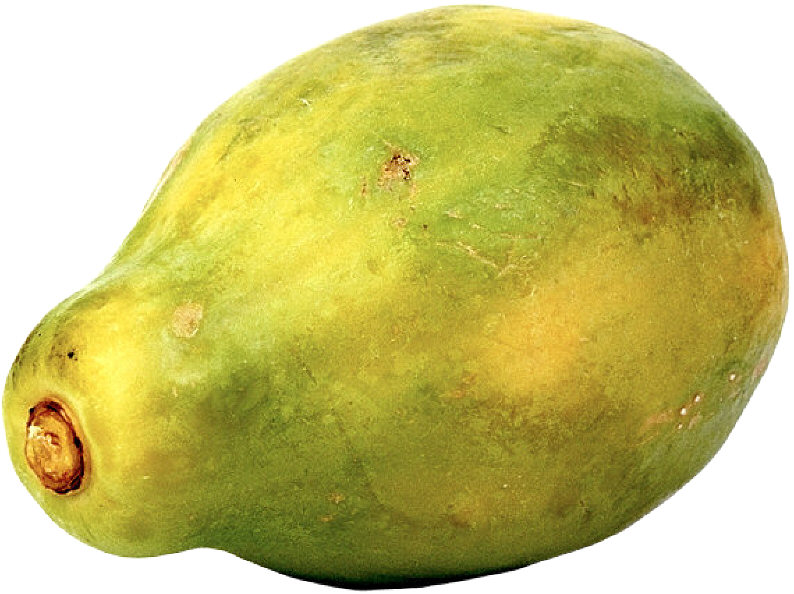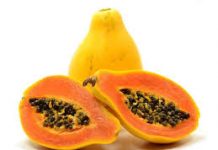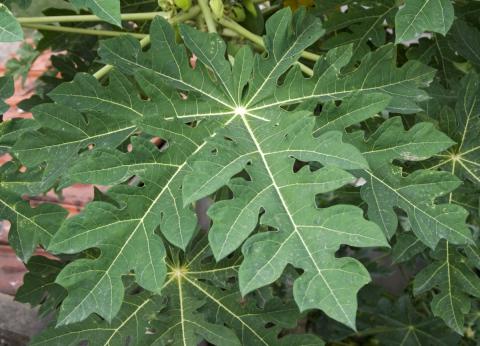 Variety
Variety
Various accessions of land races and exotic varieties such as Homestead, Pink solo, Kapoho solo and JS.22 are available at the National Horticultural Research Institute (NIHORT). Since fruit size, shape, pulp color, and time of fruiting differ, advice must be sought in selecting which variety to plant.
Nursery
Although pawpaw may be planted directly in the orchard, considerable savings can be made on seeds and labor, by using transplanted seedlings raised in the nursery. Raise seedling from seeds extracted from ripe pawpaw fruits.
Scrub the seeds lightly with sand to remove the gelatinous covering. Mix the slurry of sand with water; the bad seeds and gelatinous covering of the seed will float. These should be removed. Drain the good seeds and spread out in the shade to air dry. Sow the air-dried seed trays, polybags or any cont- -ainer which has rich moist topsoil by watering every other day. The seeds should germinate within 2 weeks and be ready for transplanting within 8–12 weeks after sowing. Seeds meant for transplanting in May should be sown in February/March.
Orchard management
Site the orchard on a well-drained soil. Although loamy sand is preferred, pawpaw can tolerate a wide range of soils provided it is not waterlogged. Plough and harrow the orchard site and plant the seedlings in holes of 15 cm —20 cm deep and 2 x 2 m spacing. In large planting areas, after planting 10 rows, leave a corridor of 4 m to allow movement of equipment. Plant 3 or 4 seedlings per hole when using a dioecious variety, to ensure a high female population. Transplant the seedlings when the rains have stabilized. Homestead plants set fruit 3 months after transplanting and ripening starts 8 months after transplanting and lasts 3 months. Harvest fruit at “Blush” stage and avoid bruising. About 40—70 t/ha can be obtained since yield declines after second harvest. Plants should be cut down after 3 years, a break crop can be planted before the old trees are cut down on the same site and used again. Establish another orchard 2 years after the bearing orchard to ensure a continuous fruit supply.
Fertilizer application
Apply 50 g of NKP 15-15-15 per plant , 3 weeks after transplanting and at monthly intervals up to 6 months after transplanting. Optimum yields have been obtained using 45 g N/plant and a 1:2 N: P ratio. However, application rates should be based on soil test results in order to make maximum use of the fertilizer application.
Weeding
Weed contol is very important especially during the first 3 months after transplanting. This may be achieved by hoe weeding, slashing at monthly intervals , or by the use of the herbicide Paraquat glyphosate at 4—6 or 3 kg active ingredient per hectare.
Irrigation
Dry season irrigation is important for pawpaw. For newly transplanted seedlings, apply 3 liters of water per plant twice a week, For flowering plants, apply 5 litres twice a week, and for bearing plants apply 15 liters of water per plant once a week.
Intercropping
Intercrop pawpaw, planted at a spacing of 2 x 2 m, with early maturing plants like okra, leafy vegetable, melon, sweet potato, or sweet corn. These plants should mature within 3 months or poor yields will be obtained due to shading of pawpaw canopies.
Pest control
Nematode control is very important. This can be achieved by applying a teaspoonful of Furadan per seedling, 3 weeks after transplanting and rotating the orchard. If grasshoppers invade the plot spray Gamalin 20 15 mls/10 liters of water.
Summary;
1. Use recommended variety
2. Use recommended spacing
3 Apply fertilizer as recommended
4 Irrigate in the dry season
5 Harvest at ‘Blush’ stage




